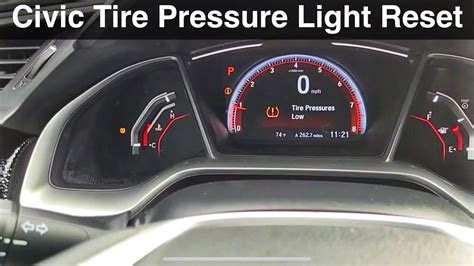Honda Civic: Easy Tire Pressure Maintenance
Maintaining the correct tire pressure in your Honda Civic is crucial for safety, fuel efficiency, and tire longevity. Under-inflated tires can lead to poor handling, reduced fuel economy, and increased wear, while over-inflation can result in a harsher ride and increased risk of tire blowouts. This guide provides a step-by-step approach to easily maintaining the ideal tire pressure for your Honda Civic.
Where to Find Your Honda Civic's Recommended Tire Pressure?
Before you even grab your tire pressure gauge, you need to know the recommended tire pressure for your specific Honda Civic model and year. This information isn't just a guess; it's critical for optimal performance and safety. You can find this information in a few key places:
- Driver's Side Doorjamb: Check the sticker on the driver's side doorjamb. This sticker usually lists the recommended tire pressure for both the front and rear tires, as well as the recommended pressure when the car is fully loaded. This is often referred to as the "cold tire pressure," meaning the pressure should be checked when the tires haven't been driven on recently.
- Owner's Manual: Your Honda Civic's owner's manual provides detailed information on tire pressure, including specifics for different tire sizes and loading conditions. This is a valuable resource, especially if you have questions beyond the sticker on the doorjamb.
Important Note: The recommended pressure may vary slightly depending on your Civic's trim level and optional equipment. Always prioritize the information found in your owner's manual.
How Often Should I Check My Honda Civic's Tire Pressure?
Ideally, you should check your Honda Civic's tire pressure at least once a month, and before any long trip. Extreme temperature changes (both hot and cold) can significantly affect tire pressure. Even without driving, pressure can fluctuate due to temperature variations. Regular checks ensure you are always driving with optimally inflated tires.
What Tools Do I Need to Check My Tire Pressure?
You'll only need a few simple tools:
- Tire Pressure Gauge: A reliable tire pressure gauge is essential. Avoid cheap gauges, as inaccurate readings can lead to improper inflation. Analog or digital gauges both work effectively.
- Air Compressor (Optional): While not strictly necessary for checking pressure, an air compressor will allow you to adjust the pressure if needed. Many gas stations offer free air compressors.
Step-by-Step Guide to Checking and Adjusting Tire Pressure in Your Honda Civic
-
Park on a Level Surface: Ensure your Honda Civic is parked on a level, stable surface. Uneven ground can lead to inaccurate pressure readings.
-
Let the Tires Cool: Check tire pressure when the tires are "cold"—meaning they haven't been driven on for at least three hours, or preferably overnight. Driving heats up the tires, increasing the pressure reading.
-
Locate the Valve Stem: The valve stem is the small, protruding metal part on the tire where you'll attach the gauge.
-
Attach the Pressure Gauge: Firmly press the pressure gauge onto the valve stem. You should hear a hiss of air as the gauge reads the pressure.
-
Read the Pressure: Note the reading displayed on the gauge. Compare this to the recommended pressure listed on your doorjamb sticker or in your owner's manual.
-
Add or Remove Air: If the pressure is too low, use an air compressor to add air to the tire. If the pressure is too high, use the valve stem to slowly release air until it reaches the recommended pressure.
-
Repeat for All Tires: Repeat steps 3-6 for each tire on your Honda Civic.
-
Check Regularly: Make tire pressure checks a regular part of your car maintenance routine.
What if My Tire Pressure is Consistently Low?
If you find your tire pressure consistently low, despite regular checks and adjustments, there could be a slow leak. You may need to investigate the cause, potentially involving a visual inspection for punctures, or a visit to a tire professional.
How Do I Know If My Tires Need Replacing?
While tire pressure maintenance is crucial, don't forget that tires wear out over time. Check your tires regularly for tread wear and any visible damage. Replace tires that show significant wear or damage for optimal safety and performance.
This comprehensive guide ensures that you can easily maintain the correct tire pressure for your Honda Civic, contributing to a safer, more fuel-efficient, and longer-lasting driving experience. Remember to always refer to your owner's manual for specific recommendations tailored to your vehicle.

